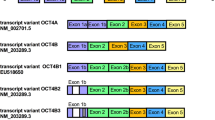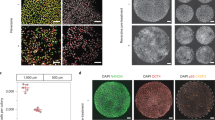Abstract
Human amniotic fluid stem cells (hAFSCs) harbor high proliferative capacity and high differentiation potential and do not raise the ethical concerns associated with human embryonic stem cells. The formation of three-dimensional aggregates known as embryoid bodies (EBs) is the principal step in the differentiation of pluripotent embryonic stem cells. Using c-Kit-positive hAFSC lines, we show here that these stem cells harbor the potential to form EBs. As part of the two kinase complexes, mTORC1 and mTORC2, mammalian target of rapamycin (mTOR) is the key component of an important signaling pathway, which is involved in the regulation of cell proliferation, growth, tumor development and differentiation. Blocking intracellular mTOR activity through the inhibitor rapamycin or through specific small interfering RNA approaches revealed hAFSC EB formation to depend on mTORC1 and mTORC2. These findings demonstrate hAFSCs to be a new and powerful biological system to recapitulate the three-dimensional and tissue level contexts of in vivo development and identify the mTOR pathway to be essential for this process.
This is a preview of subscription content, access via your institution
Access options
Subscribe to this journal
Receive 50 print issues and online access
$259.00 per year
only $5.18 per issue
Buy this article
- Purchase on Springer Link
- Instant access to full article PDF
Prices may be subject to local taxes which are calculated during checkout








Similar content being viewed by others
References
Aboushwareb T, Atala A . (2008). Stem cells in urology. Nat Clin Pract Urol 5: 621–631.
Besser D . (2004). Expression of nodal, lefty-A, and lefty-B in undifferentiated human embryonic stem cells requires activation of smad2/3. J Biol Chem 279: 45076–45084.
Blazquez C, Cook N, Micklem K, Harris AL, Gatter KC, Pezzella F . (2006). Phopshorylated KDR can be located in the nucleus of neoplastic cells. Cell Res 16: 93–98.
Bossolasco P, Montemurro T, Cova L, Zangrossi S, Calzarossa C, Miatiotis S et al. (2006). Molecular and phenotypic characterization of human amniotic fluid cells and their differentiation potential. Cell Res 16: 329–336.
Cananzi M, Atala A, DeCoppi P . (2009). Stem cells derived from amniotic fluid: new potentials in regenerative medicine. Reprod Biomed Online 18: 17–27.
Chunhui X, Inokuma MS, Denham J, Golds K, Kundu P, Gold JD et al. (2001). Feeder-free growth of undifferentiated human embryonic stem cells. Nature Biotech 19: 971–974.
Dann SG, Selvaraj A, Thomas G . (2007). mTOR complex 1-S6K1 signaling: at the cross roads of obesity, diabetes and cancer. Trends Mol Med 13: 252–259.
De Coppi P, Bartsch G, Siddiqui MM, Xu T, Santos TX, Perin L et al. (2007). Isolation of amniotic stem cell lines with potential for therapy. Nat Biotech 25: 100–106.
Dimos JT, Rodolfa KT, Niakan KK, Weisenthal LM, Mitsumoto H, Chung W et al. (2008). Induced pluripotent stem cells generated from patients with ALS can be differentiated into motor neurons. Science 321: 1218–1221.
Ditadi A, de Coppi P, Picone O, Gautreau L, Smati R, Six E et al. (2009). Human and murine amniotic fluid c-Kit+Lin- cells display hematopoietic activity. Blood 113: 3953–3960. e-pub ahead of print 12 February 2009.
Gangloff YG, Mueller M, Dann SG, Svoboda P, Sticker M, Spetz JF et al. (2004). Disruption of the mouse mTOR gene leads to early postimplantation lethality and prohibits embryonic stem cell development. Mol Cell Biol 24: 9508–9516.
Gualandris A, Noghero A, Geuna M, Arese M, Valdembri D, Serini G et al. (2008). Microenvironment drives the endothelial or neural fate of differentiating embryonic stem cells coexpressing neuropilin-1 and Flk-1. FASEB J 23: 1–11.
Guertin DA, Sabatini DM . (2007). Defining the role of mTOR in cancer. Cancer Cell 12: 9–22.
Hengstschläger M, Prusa A, Repa C, Deutinger J, Pollak A, Bernaschek G . (2005). Subtelomeric rearrangements as neutral genomic polymorphisms. Am J Med Genet 133: 48–52.
in ‘t Anker PS, Scherjon SA, Kleijburg-van der Keur C, Noort WA, Claas FH, Willemze R et al. (2003). Amniotic fluid as a novel source of mesenchymal stem cells for therapeutic transplantation. Blood 102: 1548–1549.
Itskovitz-Eldor J, Schuldiner M, Karsenti D, Eden A, Yanuka O, Amit M et al. (2000). Differentiation of human embryonic stem cells into embryoid bodies comprising the three embryonic germ layers. Mol Med 6: 88–95.
Karlmark KR, Freilinger A, Marton E, Rosner M, Lubec G, Hengstschläger M . (2005). Activation of ectopic Oct4 and Rex-1 promoters in human amniotic fluid cells. Int J Mol Med 16: 987–992.
Kim J, Lee Y, Kim H, Hwang KJ, Kwon HC, Kim SK et al. (2007). Human amniotic fluid-derived stem cells have characteristics of multipotent stem cells. Cell Prolif 40: 75–90.
Kim GD, Kim GJ, Seok JH, Chung H-M, Chee K-M, Rhee G-S . (2008). Differentiation of endothelial cells derived from mouse embryoid bodies: a possible in vitro vasculogenesis model. Toxic Lett 180: 166–173.
Koike M, Sakaki S, Amano Y, Kurosawa H . (2007). Characterization of embryoid bodies of mouse embryonic stem cells formed under various culture conditions and estimation of differentiation status of such bodies. J Biosci Bioeng 104: 294–299.
Kolambkar YM, Peister A, Soker S, Atala A, Guldberg RE . (2007). Chondrogenic differentiation of amniotic fluid-derived stem cells. J Mol Histol 38: 405–413.
Kurosawa H . (2007). Methods for inducing embryoid body formation: in vitro differentiation system of embryonic stem cells. J Biosci Bioeng 103: 389–398.
Lim SM, Pereira L, Wong MS, Hirst CE, VanVranken BE, Pick M et al. (2008). Enforced expression of Mix1 during mouse ES cell differentiation suppresses hematopoietic mesoderm and promotes endoderm formation. Stem Cells 27: 363–374.
Maherali N, Hochedlinger K . (2008). Induced pluripotency of mouse and human somatic cells. Cold Spring Harb Symp Quant Biol 73: 157–162.
Narita N, Bielinska M, Wilson DB . (1996). Cardiomyocyte differentiation by GATA-4 deficient embryonic stem cells. Development 122: 3755–3764.
Ng ES, Davis RP, Azzola L, Stanley EG, Elefanty AG . (2005). Forced aggregation of defined numbers of human embryonic stem cells into embryoid bodies fosters robust, reproducible hematopoietic differentiation. Blood 106: 1601–1603.
Park I-H, Arora N, Huo H, Maherali N, Ahfeldt T, Shimamura A et al. (2008). Disease-specific induced pluripotent stem cells. Cell 134: 877–886.
Pennings G . (2007). The ethics of using embryos in research. Reprod Biomed Online 14: 92–97.
Perin L, Giuliani S, Jin D, Sedrakyan S, Carraro G, Habibian R et al. (2007). Renal differentiation of amniotic fluid stem cells. Cell Prolif 40: 936–948.
Perin L, Sedrakyan S, Da Sacco S, De Filippo R . (2008). Characterization of human amniotic fluid stem cells and their pluripotential capability. Methods Cell Biol 86: 85–99.
Pesce M, Schöler HR . (2001). Oct-4: gatekeeper in the beginnings of mammalian development. Stem Cells 19: 271–278.
Prusa AR, Marton E, Rosner M, Bernaschek G, Hengstschläger M . (2003). Oct4 expressing cells in human amniotic fluid: a new source for stem cell research? Hum Reprod 18: 1489–1493.
Prusa AR, Marton E, Rosner M, Bettelheim D, Lubec G, Pollak A et al. (2004). Neurogenic cell in human amniotic fluid. Am J Obstet Gyn 191: 309–314.
Rosner M, Freilinger A, Hanneder M, Fujita N, Lubec G, Tsuruo T et al. (2007). p27 localization depends on the tumor suppressor protein tuberin. Hum Mol Genet 16: 1541–1556.
Rosner M, Hanneder M, Siegel N, Valli A, Fuchs C, Hengstschläger M . (2008). The mTOR pathway and its role in human genetic diseases. Rev Mutat Res 659: 284–292.
Rosner M, Hengstschläger M . (2008). Cytoplasmic and nuclear distribution of the protein complexes mTORC1 and mTORC2: rapamycin triggers dephosphorylation and delocalization of the mTORC2 components rictor and sin1. Hum Mol Genet 17: 2934–2948.
Rosner M, Hofer K, Kubista M, Hengstschläger M . (2003). Cell size regulation by the human TSC tumor suppressor proteins depends on PI3 K and FKBP38. Oncogene 22: 4786–4798.
Sampath P, Pritchard DK, Pabon L, Reinecke H, Schwartz SM, Morris DR et al. (2008). A hierarchical network controls protein translation during murine embryonic stem cell self-renewal and differentiation. Cell Stem Cell 5: 448–460.
Sarbassov DD, Ali SM, Sengupta S, Sheen J-H, Hus PP, Bagley AF et al. (2006). Prolonged rapamycin treatment inhibits mTORC2 assembly and Akt/PKB. Mol Cell 22: 159–168.
Sato N, Meijer L, Skaltsounis L, Greengard P, Brivanlou AH . (2004). Maintenance of pluripotency in human and mouse embryonic stem cells through activation of Wnt signaling by a pharmacological GSK-3-specific inhibitor. Nat Med 10: 55–63.
Shiota C, Woo JT, Lindner J, Sleton KD, Magnuson MA . (2006). Multiallelic disruption of the rector gene in mice revelas that mTOR complex 2 is essential for fetal growth and viability. Dev Cell 11: 583–589.
Siegel N, Rosner M, Hanneder M, Valli A, Hengstschläger M . (2007). Stem cells in amniotic fluid as new tools to study human genetic diseases. Stem Cell Rev 3: 256–264.
Takahashi K, Tanabe K, Ohnuki M, Narita M, Ichisaka T, Tomoda K et al. (2007). Induction of pluripotent stem cells from adult human fibroblasts by defined factors. Cell 131: 861–872.
Trounson A . (2007). A fluid means of stem cell generation. Nature Biotech 25: 62–63.
Tsai M-S, Hwang S-M, Tsai Y-L, Lee J-L, Chang Y-L . (2006). Clonal amniotic fluid-derived stem cells express characteristics of both mesenchymal and neural stem cells. Biol Reprod 74: 545–551.
Tsai M-S, Lee J-L, Chang Y-J, Hwang S-M . (2004). Isolation of human multipotent mesenchymal stem cells from second-trimester amniotic fluid using a novel two-stage culture protocol. Hum Reprod 19: 1450–1456.
Ungrin MD, Joshi C, Nica A, Bauwens C, Zandstra PW . (2008). Reproducible, ultra high-throughput formation of multicellular organization from single cell suspension-derived human embryonic stem cell aggregates. PLoS ONE 3: e1565.
Wullschleger S, Loewith R, Hall M . (2006). TOR signaling in growth and metabolism. Cell 124: 471–484.
Yamashita J, Itoh H, Hirashima M, Ogawa M, Nishikawa S, Yurugi T et al. (2000). Flk1-positive cells derived from embryonic stem cells serve as vascular progenitors. Nature 408: 92–96.
Yang Q, Guan K-L . (2007). Expanding mTOR signaling. Cell Res 17: 666–681.
Acknowledgements
Research in our laboratory is supported by the FWF Austrian Science Fund (P18894-B12), by the Herzfelder'sche Familienstiftung and by the Research Training Network ‘Developing a stem cell based therapy to replace nephrons lost through reflux nephropathy’ (http://www.kidstem.org) funded by the European Community as part of the Framework program 6 (FP6 036097–2).
Author information
Authors and Affiliations
Corresponding author
Rights and permissions
About this article
Cite this article
Valli, A., Rosner, M., Fuchs, C. et al. Embryoid body formation of human amniotic fluid stem cells depends on mTOR. Oncogene 29, 966–977 (2010). https://doi.org/10.1038/onc.2009.405
Received:
Revised:
Accepted:
Published:
Issue Date:
DOI: https://doi.org/10.1038/onc.2009.405
Keywords
This article is cited by
-
Multipotent fetal stem cells in reproductive biology research
Stem Cell Research & Therapy (2023)
-
Amniotic fluid stem cells and the cell source repertoire for non-invasive prenatal testing
Stem Cell Reviews and Reports (2022)
-
Rictor/mTORC2 involves mitochondrial function in ES cells derived cardiomyocytes via mitochondrial Connexin 43
Acta Pharmacologica Sinica (2021)
-
Human amniotic fluid stem cells are able to form embryoid body-like aggregates which performs specific functions: morphological evidences
Histochemistry and Cell Biology (2021)
-
Rapamycin regulates autophagy and cell adhesion in induced pluripotent stem cells
Stem Cell Research & Therapy (2016)



